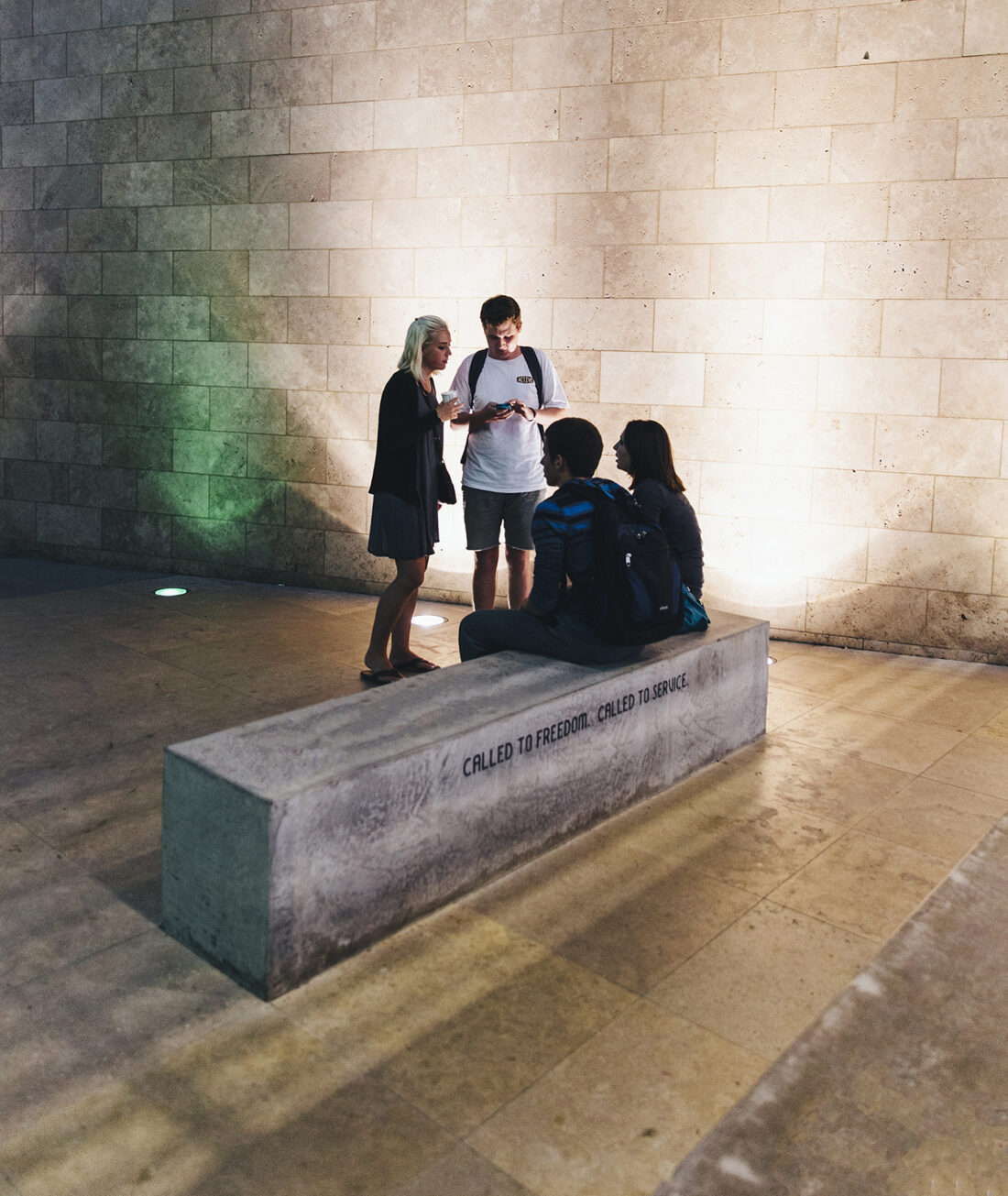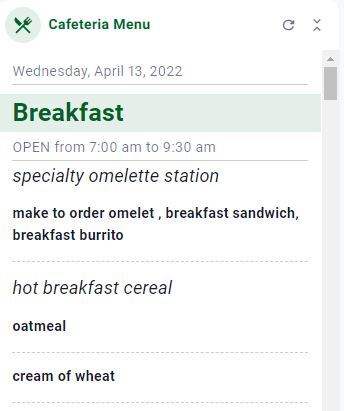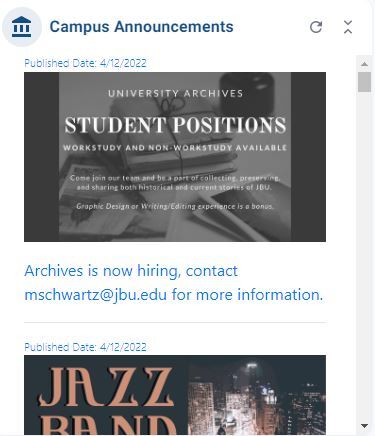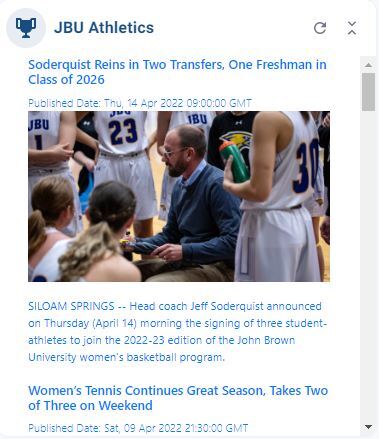Pathify Customer Story
Your Hub, Your Way

Featuring

Personalize Your Hub
Enhancing Your Engagement Hub Experience with Custom Widgets
It’s almost lunch time on the Concordia University Irvine (CUI) campus and students are planning. Is the dining hall open for lunch yet? What’s on the menu? There’s nothing worse than showing up hungry to find locked doors or nothing you feel like eating. Luckily, that’s not a problem for CUI students.
Shortly after launching their new student portal (powered by Pathify), CUI worked with Pathify to create a custom widget that pulls key information from the cafeteria website directly into the portal. The widget shows breakfast, lunch, and dinner hours along with what items are available that day.
“The menu gets looked at a lot. I think that’s one of the most used widgets,” said Ryan Jones, Director of Data Integration Services at Concordia University Irvine. “We see a huge spike of activity within the app at around 9:30 in the morning. I’m guessing that’s when students are looking at what’s for lunch.”
No two schools are the same. The information you want to surface, how it’s formatted, and who sees it is unique to your institution. So while out-of-the-box student portal widgets are helpful, they’re not the end-all, be-all. Enter custom widgets.

Envisioning Custom Widgets
Custom widgets let institutions create a portal experience that perfectly matches the needs of their students, faculty, alumni, and prospective students.
“Having very CUI-specific widgets definitely improves the experience,” Ryan said.
John Brown University (JBU) considers custom widgets a vital component of their engagement hub, called Eaglenet. Since the school replaced Sharepoint with Pathify, custom widgets ensured information users were used to seeing didn’t “disappear” during the platform shift, said Jonathan Dennis, Director of Application Services at JBU.
“The ability to do custom widgets is pretty essential to what we wanted to show to the students,” he explained. “A lot of our custom widgets are things we had on our old portal that we wanted to recreate. These were things that staff or students were used to seeing before. If they said, ‘Where is this info I used to see before?’ we wanted to be able to recreate that in the new portal.”
Customization capabilities also let John Brown University expand their widgets, creating a better experience instead of just a straight portal replacement. They created custom widgets that make it easier for users to access critical tools and keep up with campus news and events. A few JBU custom widgets include:
- Help desk
- CloudPrint (which links to JBU’s printing solution)
- School newspaper feed
- Athletics
CUI also created a custom Athletics widget. It was the first widget they built entirely in-house and gives students easy access to upcoming athletic events, recent results, and links to live sports streams. Information is pulled from the CUI athletics website into the platform via API.
Even though this information is available in other places, the ability to surface it in a centralized engagement hub ensures users see the information and generally makes it easier to find, Ryan explained.
“Even though athletics events are imported into the events portion of the portal, the widget got really, really positive feedback,” he said. “Being able to click to go directly to the live stream or see the results at a quick glance rather than going out to the athletics webpage, that was huge.”
Thinking back on his experience as a student, Jonathan appreciates being able to give JBU students easy access to as much information as possible. Creating a centralized hub for everything they need helps drive adoption and engagement, he said.
“This information is something students have come to expect to be available. Anything we can do to make it easy for them to find commonly used information is a win,” Jonathan said. “If we didn’t have these widgets, we’d have to have some other specialized page to hunt around for in a different location, so I really do think having it all in one spot is a huge benefit.”

Something Completely New or Just Custom Tweaks
Customization doesn’t necessarily mean building something completely new. For some schools, making tweaks to existing widgets is enough. In addition to creating completely unique widgets, CUI worked with Pathify to customize standard widgets to better fit their needs.
For instance, an “Email Your Professor” button was added to the standard Courses widget. The Faculty Schedule widget received similar customization, enabling faculty members to email their entire class with the click of a button. These tweaks were made using custom API work.
“The Balances Due and the Courses widgets weren’t 100% DIY, but the aspects that we did build — like emailing your entire class — have been receiving a lot of positive feedback,” Ryan said.

DIY or Delivered
While every institution can benefit from custom widgets, how they’re created is just as unique as the widgets themselves. Some schools have robust IT teams that want to handle as much in house as possible, others have one or two specialized staff who enjoy creating custom widgets, still others want finished products plugged into their platform. Pathify supports it all. Pathify works with customers to scope and build custom widgets or offers DIY training for schools that want to take a more hands-on approach.
“During our sales process we scoped out a number of custom widgets we wanted Pathify to build for us and obviously each of those comes with a cost,” Ryan explained the CUI experience. “So when they said, ‘You can do DIY training,’ obviously that was ideal for us. If we ever want to spin up something else we can do it internally.”
This also gives schools the ability to develop custom widgets however they like. Pathify gives each customer access to its proprietary middleware Flow, enabling robust widget building, but customers aren’t restricted to Flow. JBU opted to stand up several custom widgets using iframes.
“Pathify’s ability to have a link that goes to an iframe of whatever we want to surface on our end has been huge. We already had the skills to do it that way so it just made sense,” Jonathan explained. “Not forcing us to go through some other product or some predefined way to do it, having that flexibility is great.”
Creating a Custom Experience to Drive Adoption
Custom widgets are all about knowing your end users — whether it’s students looking for help navigating their higher ed experience or faculty appreciating tools that make course management easier. Creating widgets that match real user needs keeps people coming back, especially when those widgets are surfaced based on user roles.
“Having the flexibility to give certain information or targeted information to the students is very beneficial for us,” Jonathan commented.
Because of the popularity of these widgets, departments across campus are imagining how they can better integrate important information inside CUI’s portal, Ryan said.
“Once everybody saw the Athletics widget it was like, ‘Oh, we use this ticketing site’ or ‘We do our events over here, can we have that too?’ So there’s a list of a few possible new custom widgets. We’re working on one for Fine Arts now.”
